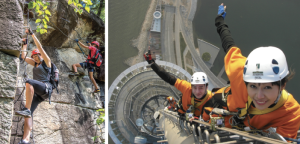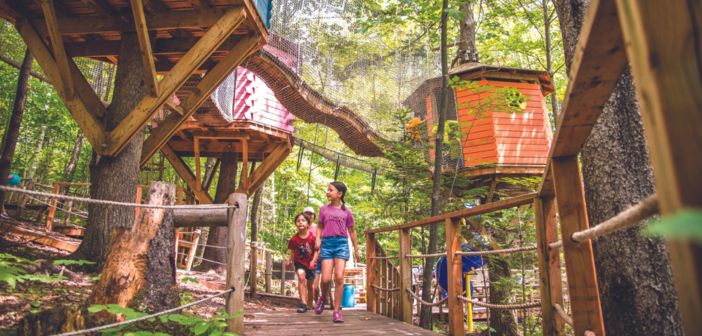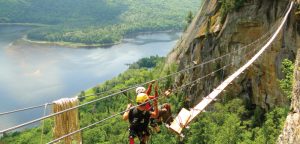Based near Montreal, The Trekking Group builds, designs, operates, and consults on adventure parks and aerial attractions throughout North America—and around the world—under several brands. All have a common goal: Create outdoor spaces that inspire people to connect with nature and encourage play, adventure, and self-realization.
The company’s story began in 2001, when owner Stéphane Vachon teamed up with then-partner Jean-Marie Bévillard (now deceased) to build and operate an adventure park under the name Arbraska. Their first park opened in Rawdon, Quebec, in June 2002, and in 2006, the pair expanded into the Ontario market under the name Treetop Trekking.
In 2015, the company began building treehouse parks for kids—called Treewalk Village—and, in 2016, it acquired Prisme, which added a variety of “cliff trekking” attractions to its portfolio and construction capabilities, including suspension bridges, elevated pathways, and via ferratas. That same year, it opened a U.S. construction division called Treetop Trekking Construction USA, and now has a Canadian arm as well. The Trekking Group formed in 2018 as an umbrella for these various divisions, which now also includes netted trampoline parks called Upla, franchise brands Treego and Arbre-en-Arbre, and more.
Today, The Trekking Group employs 725 people, operates and franchises more than 20 different adventure parks in Quebec, Ontario, New Brunswick, and Florida, and has built other attractions around the world.
Jean-François Couture, marketing director and spokesperson for The Trekking Group, recently sat down with API to talk about the company’s challenging beginnings, its recent expansion, and what the next stage of development of the adventure park industry might look like.
Adventure Park Insider: Perhaps a good place to start is with the company’s name. Why is it called The Trekking Group?
Jean-François Couture: Initially, we were doing treetop trekking activities, and then we expanded to the via ferrata, which is a cliff trekking activity. So, we do all kinds of aerial trekking; you don’t have to limit yourself to an existing path on the ground. We’re providing new ways to enjoy nature whether you’re disabled—we can imagine doing things that are more accessible, like observatories—or if you like high emotions, but you’re not a climber, the via ferrata can be a good option. We also do indoor trekking.
Everything we do is motivated by helping people reconnect with nature, reconnect with oneself, reconnect with their loved ones, their colleagues, in a fun, active, and environmentally friendly way. Whenever we build parks, we want to harmonize with nature, and we want to do it in an authentic way.
API: Even when you’re building an urban park, it’s still the same mission?
JFC: It’s always the same mission, and maybe nature doesn’t play the same role in the experience, but we want to try to make it relevant, accessible, fun, and active. We’re developing new urban activities, it’s a new avenue that we’re taking, and we always like to see how we can bring nature to people and adventure to people who don’t have access. How can we make it accessible in town, so the next step will be to come to nature and experience it for real, either at one of our parks, or whenever they go to Costa Rica, Florida, or wherever.
API: If they’re climbing around a shopping mall or something, then they might think climbing around trees would be even cooler, right?
JFC: Exactly. It’s like someone who became an engineer because of the first time they played with LEGO.
API: Does the company come from more of a nature background, a team-building background, or more of a construction background? What are your roots?
JFC: Stéphane, the owner, was a marketing analyst and business coach, and (Bévillard) came to him with an adventure park project at a time when there was no such thing in Canada. Stéphane analyzed it and decided to jump in as a co-investor, and it became second nature to harmonize his business skills with nature.
He initially started designing, building, and operating parks for his own group, but after a while people asked him if he could build something for them, so he expanded. He started to acquire other companies that had similar expertise, and that’s when he went from being just an operator to being also a builder.
API: What are some of the ways that adventure parks appeal to Canadians?
JFC: We’re fortunate to have a lot of forests, we grew up in nature, and it’s always been leisure oriented. People go there with their families. There also is team building and corporate activities, but I would say 80 percent of our clientele is the public, families with kids, and school groups, community groups.
The team building has become more obvious and relevant nowadays, with everybody working from home. How can you reconnect teams together? How can you laugh with your colleagues and laugh at your boss and just be human, to have human-to-human contact? In Toronto and other urban areas, people want to do team-building activities at an aerial adventure park to disconnect with urban life.
API: What was your experience with the first park that you built?
JFC: The first park was in Rawdon, Quebec [a tourist town about 37 miles north of Montreal, with a population of about 10,000 people], in 2002. It stands on the grounds of a former ski area and started with a dynamic challenge course. We had high expectations, but nobody showed up, because nobody knew what an adventure park was. So that was good for humility.
It’s not “if you build it, they will come.” You’ve got to attract people; you’ve got to offer an adventure that they’re going to appreciate. We learned a lot of things they don’t teach at school about how to build a business on the customer journey, the customer experience we were offering. How can we make it easy for people to come? With the parks that came later, we selected different locations where there were a lot of people, lots of tourists, and lots of locals.
When you launch a new concept, there’s a buildup to it. Stéphane went with his father all over town and they gave out flyers, they built partnerships, they talked to people; they ignited the machine—and then people showed up. For an adventure park to be vibrant and popular, it needs to be part of the community.
Rawdon is in a beautiful forest; it’s one of my favorites still. We were really inspired by nature and how people who come from Montreal and all over experience that even though they’re not expert climbers. We wanted it to look rustic, to make it as authentic as possible, similar to the European parks [at the time].
We built the foundation of our “tribe” there—the people who share the same interests, people who have the potential of connecting. We approached it like a summer camp, so all the guides there have nicknames. When they come to work, they’re called Hammer, or they’re called Rocky. We’ve been able to create something cool, and that connected us quickly with our audience as we connected our employees with one another.
API: What would you say the personality of the company is?
JFC: If we were a celebrity, we would be a hybrid between Indiana Jones and Drew Barrymore. The adventurous girl next door. We really want people to have a good time, and to do that we’ve got to be adventurous, but not “expert adventurous,” because we’re going to scare people off.
API: Why did you branch off into some of these other projects, like the via ferrata and the walking paths?
JFC: We saw a great opportunity in places where you have a lot of land: maybe you’ve got a mountain with a cliff; some other places, you’ve got a lake, a river. We really adapt to the land and its particularities. For example, we’ve got a cave at a park in the Gatineau area close to Ottawa. When we took over the park 10 years ago, there were 70 bats; we’ve been able to operate the cave, do discovery tours and explorations and guided tours, and now there are over 700 bats. We operate it when they’re not around, so we coexist with these guys.
We really love via ferrata, it’s a great activity, very popular in Europe but relatively unknown in North America. It’s thrilling. It’s safe compared to rock climbing. A lot of people don’t do rock climbing because it looks too complicated or dangerous, while a via ferrata is an iron pathway where you’re secured. We purchased a company that specializes in them a few years ago [Prisme] and integrated it in our activities.
After building via ferratas in the U.S. and Canada, we started building suspended bridges because we now had the expertise of building on cliffs and rock faces. We’re pushing our limits and pushing the limits of the industry.
Last year we [launched]a new product called Upla, which are North America’s largest outdoor trampolines. We initially tried it at our first park in the Montreal area, and we had such a great success we built one in Toronto this year [2023], and we’re expanding it to other locations. It’s a universe of nets, 20 to 35 feet up in the air, with two-story trampolines and 2,000 square meters (21,527 square feet) of nets.
At our adventure parks in Quebec, we need one employee for 15 guests. For Upla, we need three employees for 200 guests. So, this enables us to operate without being affected that much about the employee shortage crisis for creating those new attractions.

Left: Via ferrata at Arbraska, Rawdon, Quebec. Right: Dizzying heights at Macau Tower Skywalk, Macau, China.
API: This is really about maximizing the space and the landscape that you have to bring as many attractions as possible to people, so they have choices of things to do.
JFC: If you want guests to come back, you’ve got to come up with something new. So, we’ve added the via ferrata, we added a Treewalk Village. Adding things through time really showed us that it helps attract people over and over again, grow our audience, and grow our business. That’s why it became important for us to maximize the use of our land.
API: Why is it important to provide people with access to terrain that they would not otherwise be able to, whether that’s with the via ferrata or suspension bridges or accessible installations?
JFC: One thing that really motivates us is democratizing access to nature. How can we make it available for people who are older or with disabilities or those who are afraid of heights? We’ve built observatories where you can take a wheelchair to the top and enjoy a view of nature. For the Paralympic Games in Toronto, we built a zip line that disabled people could experience.
With Upla, anyone can climb in and jump around. You become 16-years-old again, even if you’re 40. Maybe after that you’ll go on an aerial adventure course; it serves as an introduction just like the via ferrata is an introduction to those who may eventually go try rock climbing.
API: When you look at a ropes course, a treetop walk, a via ferrata, these suspension bridges and walkways—it really could be combined into a journey.
JFC: People want to get to places they’ve never been, they want to be explorers in their own lives and their own journey. We do unusual accommodation as well; we have projects where you’re spending a night in a hotel room on a cliff. So, whether it’s through storytelling or new attractions, you’ve got to evolve.
Working on the Saquenay Fjord National Park suspension bridge, Quebec.API: You mention storytelling; do you mean something with a beginning, middle, and end? A narrative that can go along with the experience?
JFC: This is happening right now, but I can’t tell you a lot about it, because this is something that we’re working on and trying to push the limits.
When you are at Disneyland, they take you to an artificial world. Why can’t we do that in nature? We just partnered with a company that just happens to do that; they lighted one of our parks, and we’re working on projects together.
What’s important is creating immersions with storytelling while being true to our values: can we do that while harmonizing with nature? Can we do it while being at an accessible price point? Can we allow people to push their limits, have fun, be active, and be environmentally friendly?
API: Can you give us an example of what you’re considering?
JFC: I was at one of our parks last summer, and there’s a zip tour where you go seven times across the water. And I looked into the story of the river and found out this is where the missionaries who came north started their quest to go deeper into Quebec. So, we cross history like seven times, and I’m working on storytelling, so guests are aware of that. There’s a story about the trees and the indigenous people who live in this area.
Linking all of that together, although it’s an adventure park, you can build a story with what you have, and then bring this experience to a new level where it’s physical, it’s active, it’s in nature, but that little touch of history that can ignite the imagination, as well.










